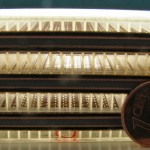Jun
11
Flying Powered by a Fuel Cell
June 11, 2008 | 4 Comments
It’s a really small helicopter, small enough that it would be workable inside of buildings or overlook land that’s unsafe for humans to occupy. But the news is the diminutive size of the fuel cell. Weighing 30 grams and delivering 12 watts, it compares to a common battery at 1.5 volts. 12 watts will get you 8 amps at 1.5 volts which is really good for 30 grams of device. 30 grams is just over an ounce! So a pound of these would get you almost 200 watts or nearly four automotive headlights.
To get to the voltages needed to power a motor adequate for lift the cells are connected in series so each one added increases the voltage as a stack of batteries would be to power a brighter lamp. The team leader is Robert Hahn at Fraunhofer Institute for Reliability and Microinnovation in Berlin, Germany. With his colleagues at the Technical University of Berlin and his own team Dr. Hahn reached a power density of 400 watts per kilogram a number only achieved in much larger systems.
At this weight, the power is dense enough to energize the flight of a 20-centimeter helicopter. The project is based on a need for very small devices that can access into fallen buildings, traffic observation and other duties that can be controlled remotely and would benefit from very small incursions.
Fuel cells are normally stacks made up of metal plates with pathways for the hydrogen and air. Metal makes them heavy. Hahn explained that the new design relies on very thin planer cells replacing the metal plates with lightweight plastic spacers. The design also eliminated pumping air into the cell as the helicopter rotor vents to the cell.
The team came up with another innovation to supply the hydrogen as carrying along a heavy high-pressure tank was a non-starter. Dr Hahn said, “We have built a small reactor containing solid sodium borohydride. If we inject water, this produces hydrogen.” As helicopters power requirements are rather stable, keeping it aloft is the main energy load, a steady supply of hydrogen is optimal. Periodic increases for acceleration and maneuvering that are lower comparable added loads, require adjustable hydrogen production to feed the cell, and is in development. As the metering of hydrogen is concluded the team expects to begin test flights within a year.
The press release also notes that the fuel cell has other uses suggesting charging point for computers and cell phones. I would think those are just the tip of the iceberg.
This is a worthwhile development, a step into miniaturizing, and the compactly combining of fuel cells into series arrangements. That is a necessary step whatever fuel is used for the fuel cell. This effort points out that the lessons we will need in larger and higher power designs are already underway.
Comments
4 Comments so far



[…] Go to the author’s original blog: Flying Powered by a Fuel Cell […]
very nice information keep posting
[…] Flying Powered by a Fuel Cell New Energy and Fuel Posted by root 1 day 33 minutes ago (https://newenergyandfuel.com) Jun 11 2008 fuel cells are normally stacks made up of metal plates with 1 comment so far flying powered by a fuel cell on june 13 2008 12 44 am Discuss | Bury | News | flying powered by a fuel cell new energy and fuel […]
Do you have a spam issue on this site; I also am a blogger, and I was wanting to know your situation; we have developed some nice practices and we are looking to exchange techniques with other folks, please shoot me an e-mail if interested.